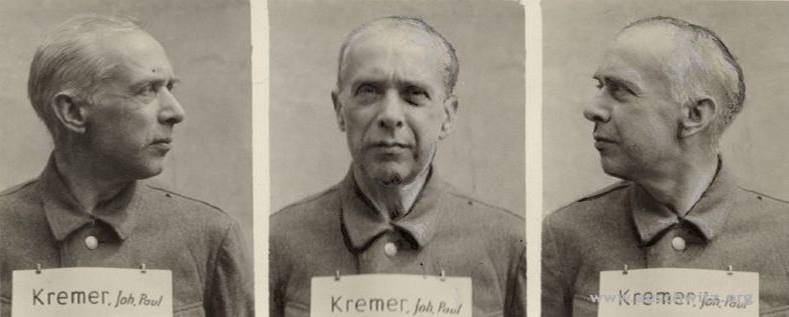On the forum and the subforum SS u polizei, member Orlov have started a topic were he list biographical data and info regarding Doctors of different positions of the SS and Waffen-SS, as an example we show the story of Johann Paul Kremer. You can see the thread here – Medical Officers of the SS

Johann Paul Kremer (26 December 1883 – 8 January 1965) was born in Stellberg. He studied in Heidelberg, Strassburg as well as Berlin; he received his philosophy degree in 1914 and his medical degree in 1919. He also studied natural science and mathematics. He was the “assistant surgeon at the surgical clinic of the University, Charité, the ward of internal diseases of the Municipal Hospital Berlin-Neukölln, the surgical clinic of the University of Cologne and prosector in the Institutes of Anatomy in Bonn and Münster. He became Dozent of anatomy in 1929 and was promoted there in 1936 to be professor in commission. At the same time, he was commissioned to lecture on the science of human hereditariness”. He also did some writing: he mentions two articles that he wrote in the diary he kept, the first being “Inherited or Acquired? A Noteworthy Contribution to the Problem of Hereditariness of Traumatic Deformations” and the second titled “New Elements of Cell and Tissues Investigations”.
Medical experiments in KZ Auschwitz
The main priority of SS doctors at concentration camps throughout German-occupied Europe was not to provide basic medical services to prisoners, but rather to give the appearance of competent medical care. Following the full-scale implementation of the Final Solution, much of their time was occupied with concentration camp exterminations, sorting/selection of the newly-arrived (primarily Jewish) prisoners (e.g. for work, experimentation, or immediate extermination), direct observation of executions and gassings, experimentation, and the fabrication of causes of deaths on prisoner death certificates. The experiments conducted by SS doctors were done for three main reasons:
1) to research methods to improve the health and survivability of soldiers;
2) to lay the groundwork for post-war scientific research and
3) to carry out the dictates of the racial policies of the National Socialist Party. Some experiments were also done at the behest of pharmaceutical companies and medical institutes, for the doctors’ own research interests, and to benefit the doctors’ personal careers.
Kremer was particularly interested in the effects of starvation on the human body, especially on the liver, and because Kremer was responsible for examining the prisoners that sought admission to the camp infirmary, he was able to personally select the prisoners that he believed would make good test subjects for his experiments. He often performed autopsies in order to extract samples from the liver, spleen and pancreas. On several occasions in his diary, he mentions the extraction of organs and tissues (which he called “living-fresh material”) from living victims.
On 3 October 1942 SS doctor Johann Paul Kremer wrote in his diary: “Today fresh living material from the human liver and spleen as well as pancreas fixed, along with lice from typhus patients fixed in pure alcohol. In Auschwitz (city), whole streets are struck down with typhus. So today I had the first serum injection against abdominal typhus administered to me. SS-Obersturmführer Schwarz is sick with typhus!”.
Also on October 15, 1942 he writes, “Living-fresh material of liver, spleen and pancreas taken from an abnormal individual.” Kremer’s diary contains descriptions of at least five more similar instances. At his hearing on July 30, 1947, Kremer stated that “I observed the prisoners in this group [to be liquidated] carefully and whenever one of them particularly interested me because of his advanced stage of starvation, I ordered the medical orderly to reserve him and to inform me when this patient would be killed by injection”.
Sonderaktion
All SS doctors were required to be present at what were called “special actions”, which was when the mass gassings took place. The most common victims were children, the elderly, mothers with young children and any others considered unfit to work. During his trial, Kremer described how a gassing was conducted and what his role as doctor was. The gassings were conducted in cabins located on the outskirts of the camp; the victims were transported by railway, and after they arrived, prisoners “were first driven to barracks where the victims undressed and then went naked to the gas chambers. Very often no incidents occurred, as the SS men kept people quiet, maintaining that they were to bathe and be deloused. After driving all of them into the gas chamber the door was closed and an SS man in a gas mask threw the contents of a Zyklon-B tin through an opening in the side wall.” Kremer’s role was to sit in a van along with a medical orderly ready to treat any officers that might succumb to the gas.


